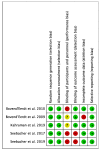Effectiveness of Motor Imagery on Motor Recovery in Patients with Multiple Sclerosis: Systematic Review
- PMID: 33435410
- PMCID: PMC7827037
- DOI: 10.3390/ijerph18020498
Effectiveness of Motor Imagery on Motor Recovery in Patients with Multiple Sclerosis: Systematic Review
Abstract
The effects of motor imagery (MI) on functional recovery of patients with neurological pathologies, such as stroke, has been recently proven. The aim of this study is to evaluate the effectiveness of MI on motor recovery and quality of life (QOL) in patients with multiple sclerosis (pwMS). A search was carried out in the following scientific databases: PubMed, CINAHL, PEDro, Scopus, Cochrane and Web of Science, up to November 2020. The grey literature and reference lists of potentially relevant articles were also searched. The Checklist for Measuring Quality and The Cochrane collaboration's tool were used to assess the methodological quality and risk of bias of the studies. Five studies were included in the systematic review. Findings showed that pwMS using MI had significant improvements in walking speed and distance, fatigue and QOL. In addition, several benefits were also found in dynamic balance and perceived walking ability. Although the evidence is limited, rehabilitation using MI with the application of musical and verbal guides (compared to non-intervention or other interventions), can produce benefits on gait, fatigue and QOL in pwMS with a low score in the Expanded Disability Status Scale.
Keywords: mental processes; motor imagery; multiple sclerosis; psychomotor performance; rehabilitation.
Conflict of interest statement
The authors declare no conflict of interest.
Figures
Similar articles
-
Effectiveness of equine-assisted therapies for improving health outcomes in people with multiple sclerosis: A systematic review and meta-analysis.Mult Scler Relat Disord. 2021 Oct;55:103161. doi: 10.1016/j.msard.2021.103161. Epub 2021 Jul 23. Mult Scler Relat Disord. 2021. PMID: 34329873
-
The effect of time spent in rehabilitation on activity limitation and impairment after stroke.Cochrane Database Syst Rev. 2021 Oct 25;10(10):CD012612. doi: 10.1002/14651858.CD012612.pub2. Cochrane Database Syst Rev. 2021. PMID: 34695300 Free PMC article.
-
Music interventions for improving psychological and physical outcomes in people with cancer.Cochrane Database Syst Rev. 2021 Oct 12;10(10):CD006911. doi: 10.1002/14651858.CD006911.pub4. Cochrane Database Syst Rev. 2021. PMID: 34637527 Free PMC article.
-
Factors and strategies affecting motor imagery ability in people with multiple sclerosis: a systematic review.Physiotherapy. 2023 Mar;118:64-78. doi: 10.1016/j.physio.2022.09.005. Epub 2022 Sep 15. Physiotherapy. 2023. PMID: 36184292
-
Early palliative interventions for improving outcomes in people with a primary malignant brain tumour and their carers.Cochrane Database Syst Rev. 2022 Jan 6;1(1):CD013440. doi: 10.1002/14651858.CD013440.pub2. Cochrane Database Syst Rev. 2022. PMID: 34988973 Free PMC article.
Cited by
-
Motor imagery and action-observation in neurorehabilitation: A study protocol in Parkinson's disease patients.Front Neurol. 2022 Oct 4;13:990618. doi: 10.3389/fneur.2022.990618. eCollection 2022. Front Neurol. 2022. PMID: 36267882 Free PMC article.
-
Children with Cerebral Palsy can imagine actions like their normally developed peers.Front Neurol. 2022 Sep 6;13:951152. doi: 10.3389/fneur.2022.951152. eCollection 2022. Front Neurol. 2022. PMID: 36147045 Free PMC article.
-
Actual and Imagined Music-Cued Gait Training in People with Multiple Sclerosis: A Double-Blind Randomized Parallel Multicenter Trial.Neurorehabil Neural Repair. 2024 Aug;38(8):555-569. doi: 10.1177/15459683241260724. Epub 2024 Jun 14. Neurorehabil Neural Repair. 2024. PMID: 38873806 Free PMC article. Clinical Trial.
-
Motor Imagery of Walking in People Living with and without Multiple Sclerosis: A Cross-Sectional Comparison of Mental Chronometry.Brain Sci. 2021 Aug 26;11(9):1131. doi: 10.3390/brainsci11091131. Brain Sci. 2021. PMID: 34573154 Free PMC article.
-
Efficacy of interoceptive and embodied rehabilitative training protocol in patients with mild multiple sclerosis: A randomized controlled trial.Front Neurol. 2022 Dec 21;13:1095180. doi: 10.3389/fneur.2022.1095180. eCollection 2022. Front Neurol. 2022. PMID: 36619928 Free PMC article.
References
-
- Fernández O., Fernández V.E., Guerrero M. Esclerosis múltiple. Med. Programa Form. Médica Contin. Acreditado. 2015;11:4610–4621. doi: 10.1016/j.med.2015.04.002. - DOI
Publication types
MeSH terms
LinkOut - more resources
Full Text Sources
Other Literature Sources
Medical




